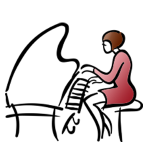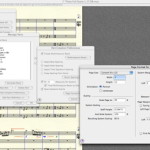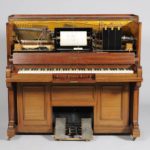In case you missed it, here’s Part 1!
I was actually pretty far ahead of the game when it came time to prepare my score, because I had been composing more or less straight into Finale all along. I used to compose on paper 100% and enter the music into the computer when I was done, but nowadays I’m going directly into the computer more and more. When I was an undergrad, one of my professors recommended against writing at the computer; he reasoned that fiddling with the program’s functions and commands interfered with focusing on composing. And given the clunkiness of the software back in the days of yore, he had a point. But I don’t think it’s true anymore. I think it’s getting to be like writing text; are there any writers today who would dream of writing by hand and typing into the computer later on? Only if they were stranded on a desert island without their laptops, I bet! 😉
Of course this means that the digitally-oriented composer is of necessity chained to the computer… but we certainly have plenty of company in that regard!
I do still sketch a few things out, mostly at the beginning, but also at several points along the way. Here’s part of a page of my chicken scratchings, where I was working out a chord progression:

By the way, those little doodles that look like 6’s are my shorthand version of a treble clef. I can’t be bothered with something that takes two pencil strokes where one would do, people! 😛 Here’s a proper treble clef, though, just to assuage any offended eyeballs:

Ah, that’s better! 😉
Follow Mr. Readmore for even prettier pictures!
Oh, but first things first: I suppose I should mention exactly which instruments I’m writing for! Well, my Theremin Concerto will be played on a program with Haydn’s Surprise Symphony, so I’m using the same instrumentation, because the musicians are being paid union scale Papa Haydn is my role model in everything. 😉
Instrumention:
2 Flutes (Flute 2 doubling Piccolo)
Oboe/English Horn
2 Bassoons
2 Horns in F
2 Trumpets in B
Percussion/Timpani (1 player)
Theremin
Strings
“Flute 2 doubling Piccolo” means that the second flute player will switch back and forth between flute and piccolo. The same applies to the Oboe player, who will also play English Horn. There’s only one oboe in my piece, because the other oboe player also happens to be the person who’s playing the Theremin solo: my good friend Scott Paulson.
“Strings” refers to the standard orchestral configuration of string instruments: first violins, second violins, violas, cellos and basses.
The instruments always appear in the score in a standard order, with winds on top, brass and percussion in the middle, and strings on the bottom. Setting this up is one of the things Finale is pretty good at doing automatically, but they also teach you the proper order when you go to composer school, so I could set it up on my own if I had to, so there. 😛
A staff for each instrument appears at the beginning of the piece, to let you know who’s showing up to the party.

Unless you’re the kind of the composer who enjoys constant, loud monotony (I won’t mention any names! 😛 ), you won’t have all of the instruments playing all of the time. To avoid wasting paper with vast stretches of empty measures, the score only displays an instrument’s staff when it’s playing. When the instrument isn’t playing, its staff disappears until it comes back in again. Here’s a place in the score where some of the instruments are resting:

Pretty neat. So, once you have your Finale doc set up with all the staves you need and none you don’t, you just enter notes in with your trusty MIDI keyboard, sprinkle a few dynamic markings and articulations on top, tie it up with slurs and glissando lines, and you’re done, right?
Ohhhh… *whimper* … so, so wrong…
Up Next: Pitfalls in Perfectionist Paradise!
If you enjoyed this post, would you consider…
Thanks — you make the world a better place! 🙂





McDoc likes to believe that he can draw a G clef, a.k.a. the treble clef, with one stroke. Honest.
In a similar vein, McDoc can also draw an ampersand in one stroke.
These are skills that, sadly, no one cares about, and that, sadder still, no one cares how difficult and OCD-driven it was to develop these obscure and arguably useless skills. But, there you are.
While we are referring to ourselves in (what our high-school selves used to call) “third-person non-existent”, Alto2 can also draw a treble clef and an ampersand each in one stroke.
Um, Lucy, can you please ‘splain what is a THEREMIN??? Why is it being featured on this program?
Have I mentioned how bummed I am that I am going to at a work conference the week you are here??